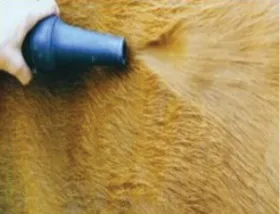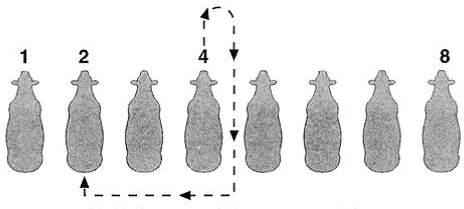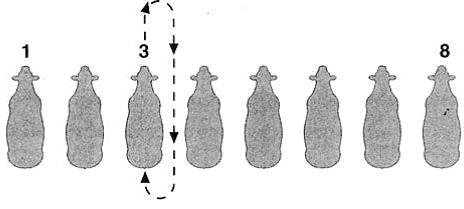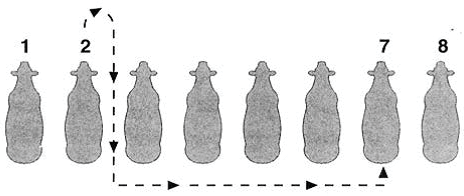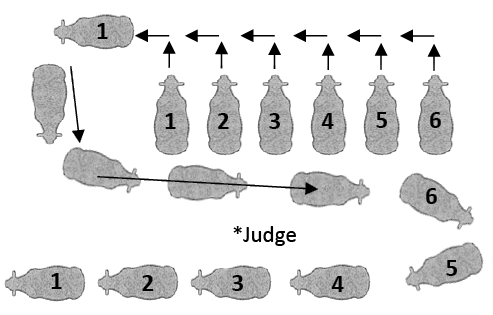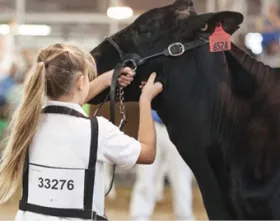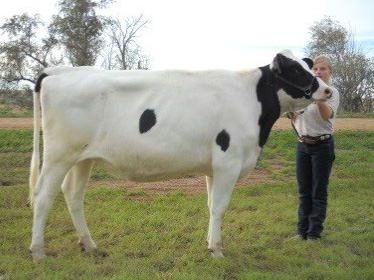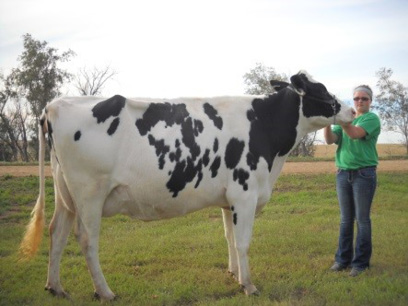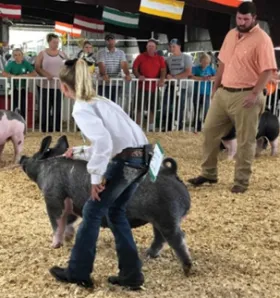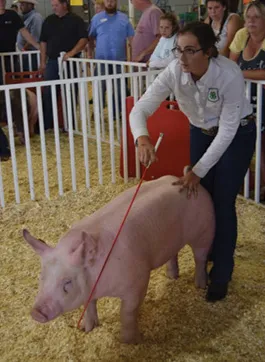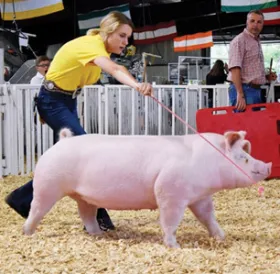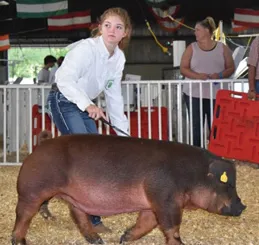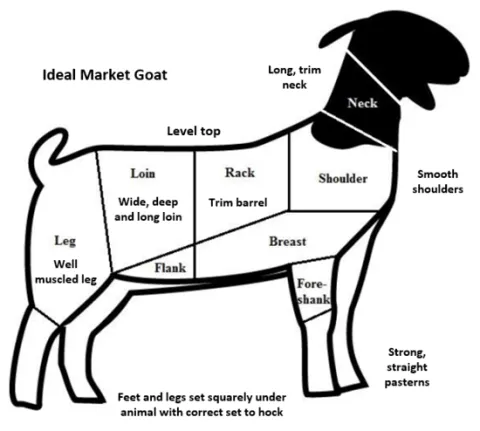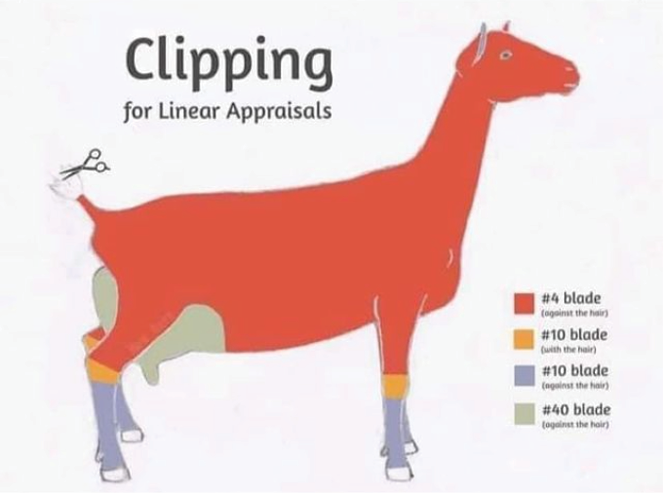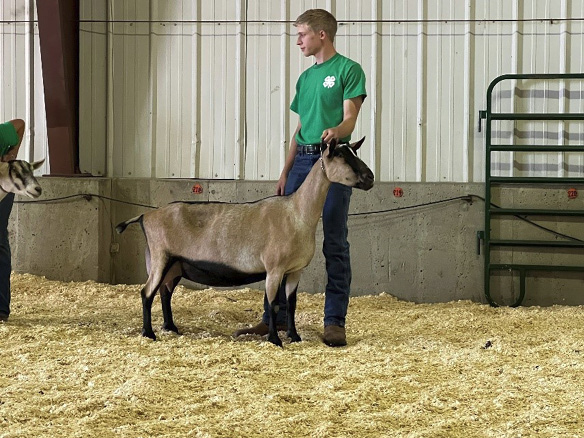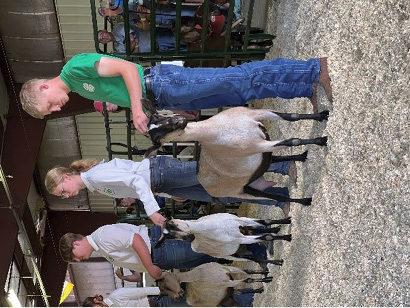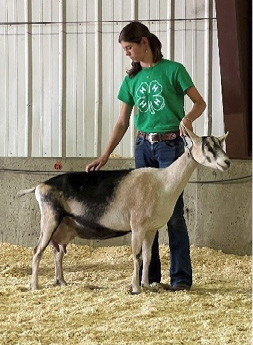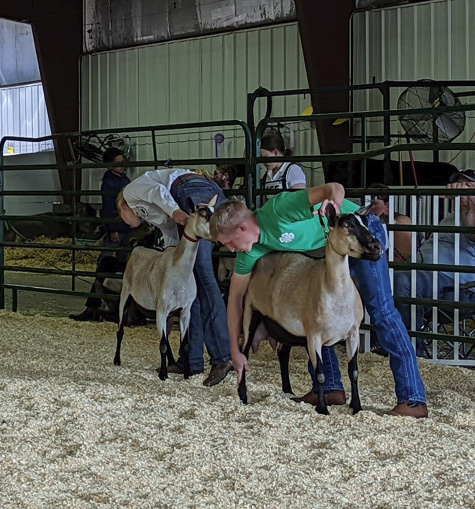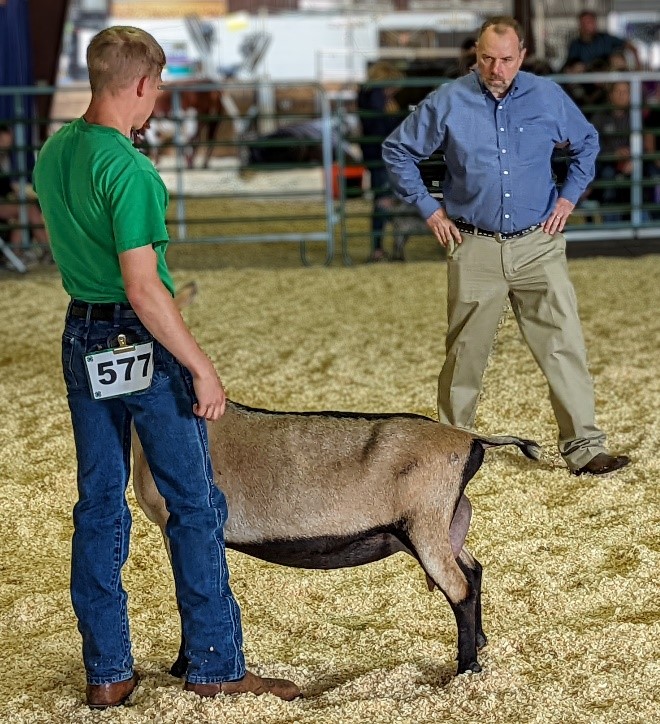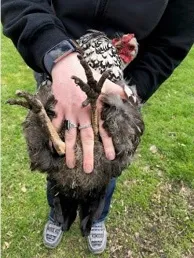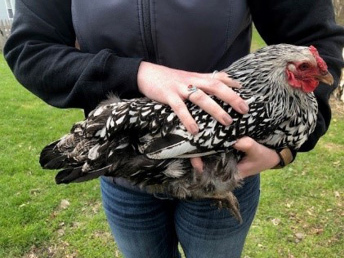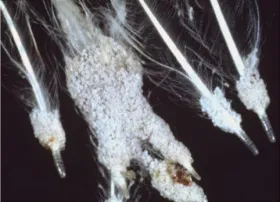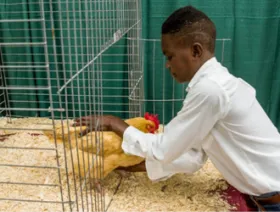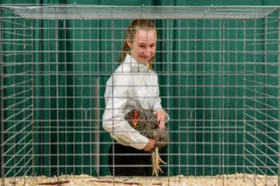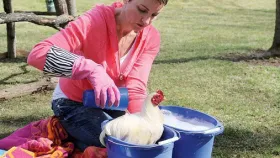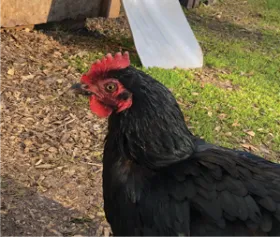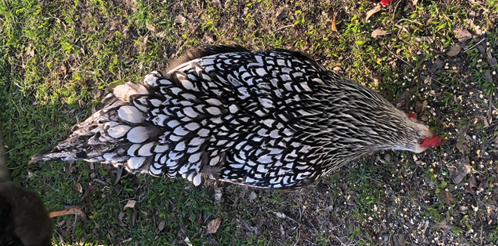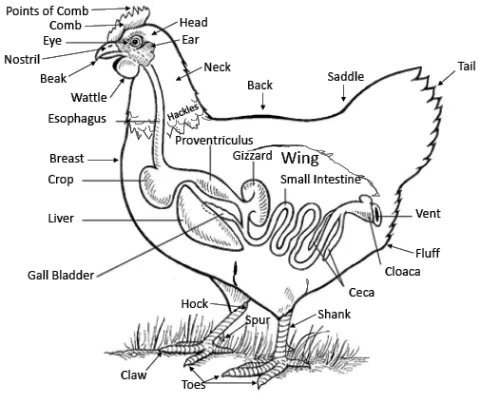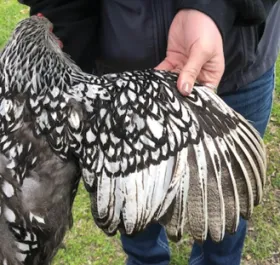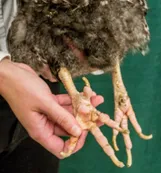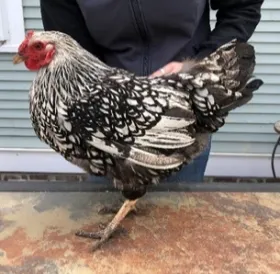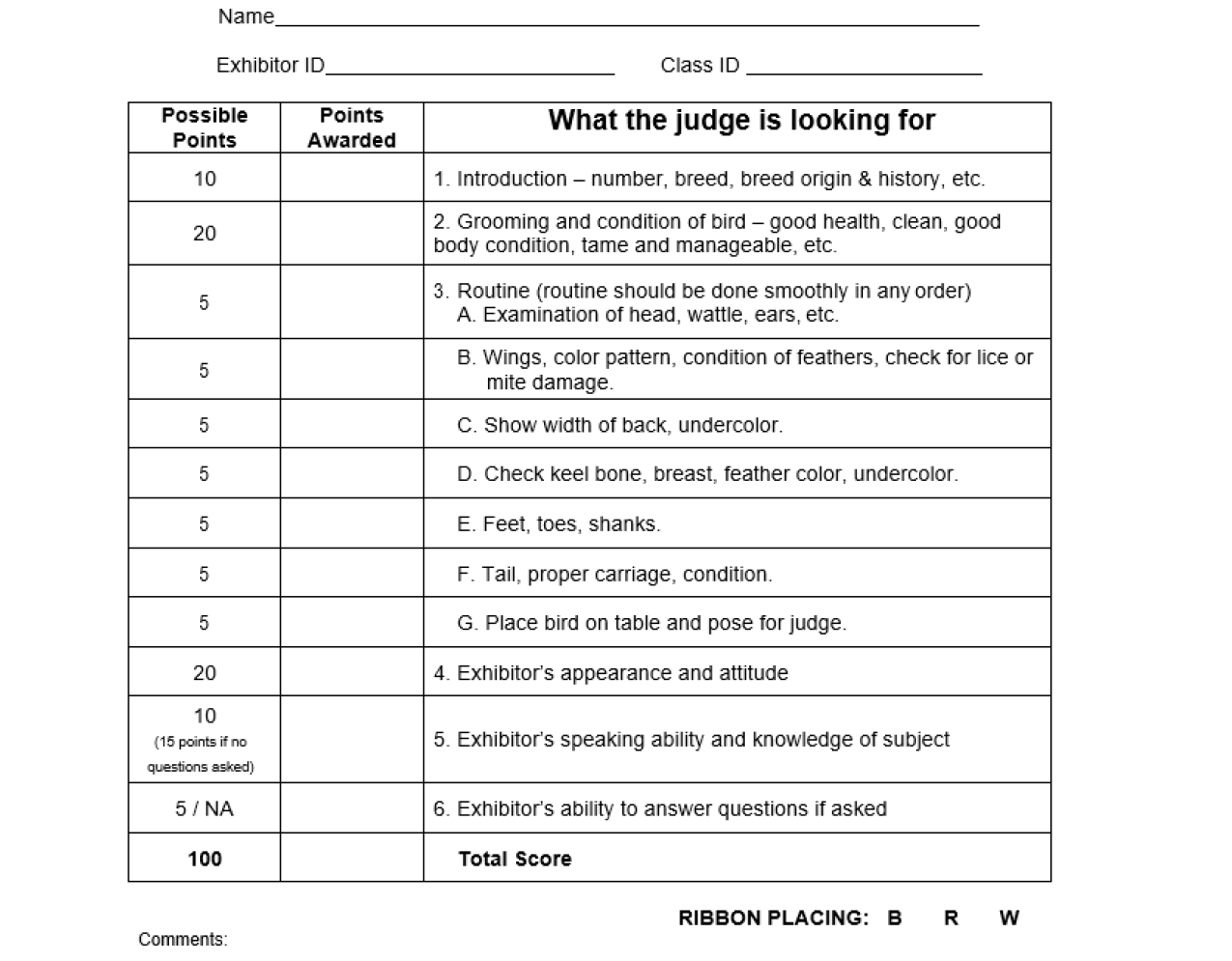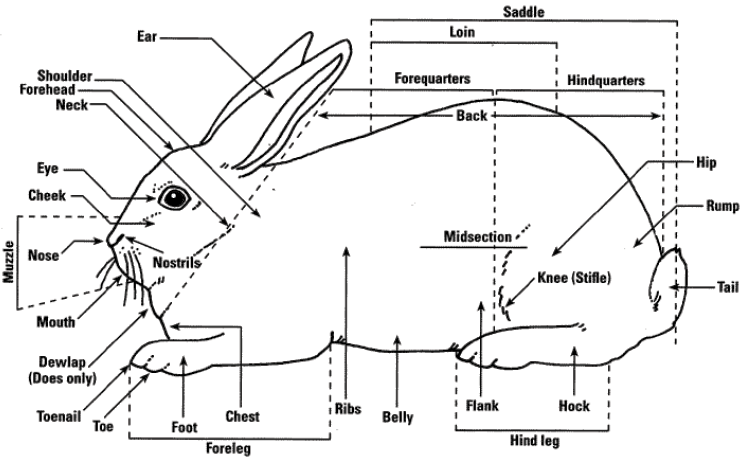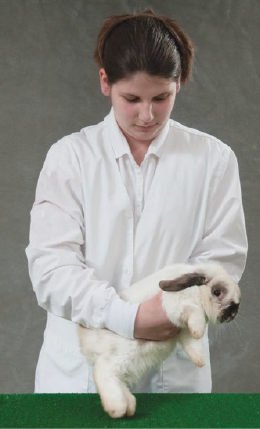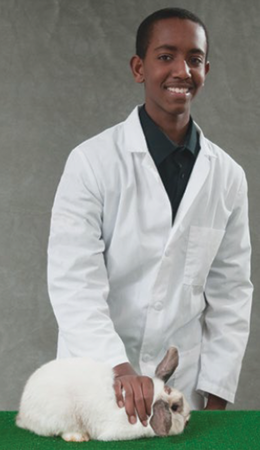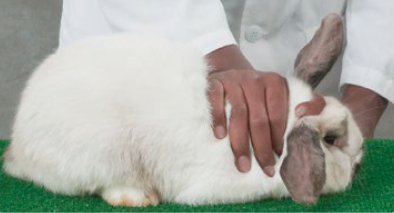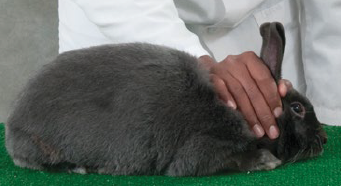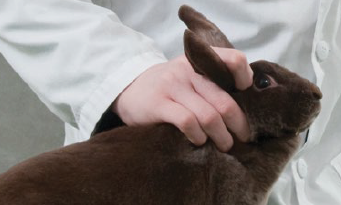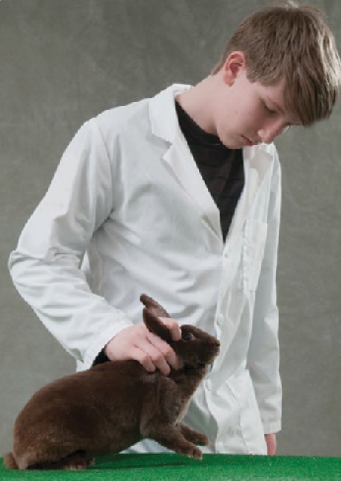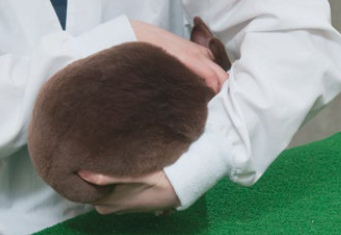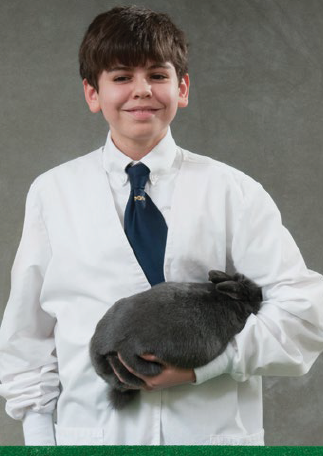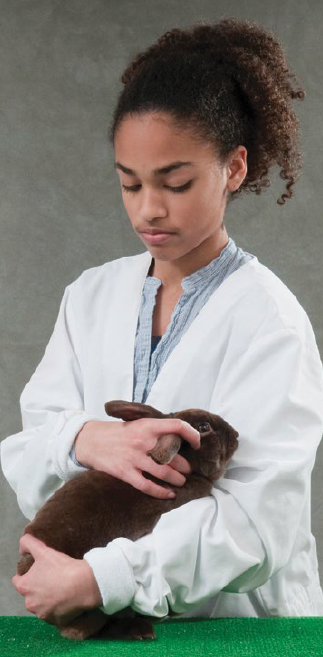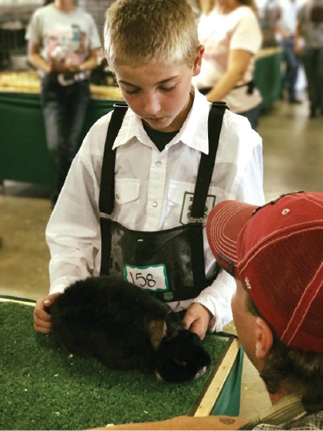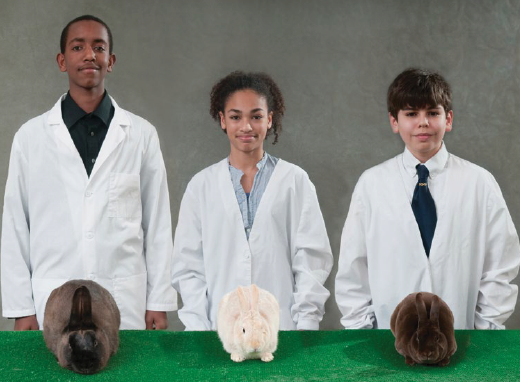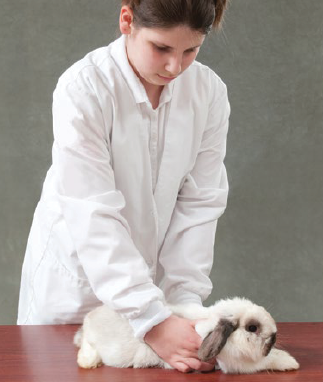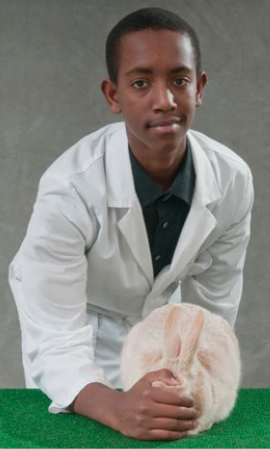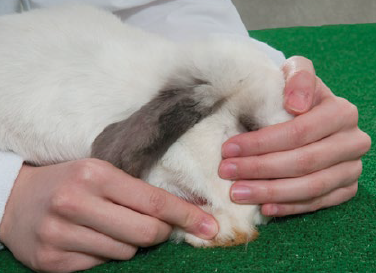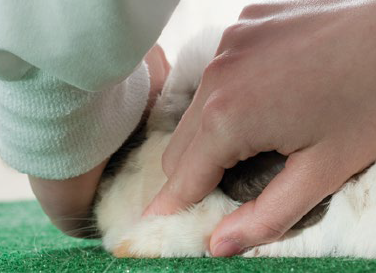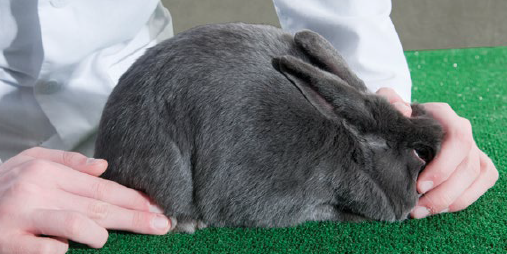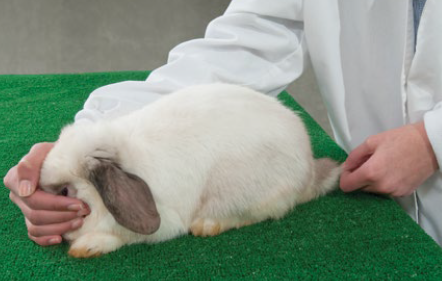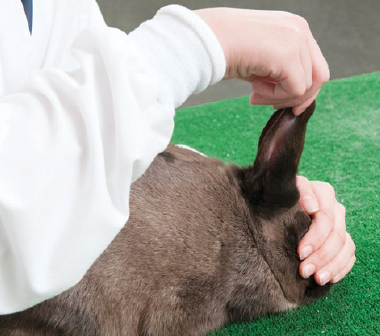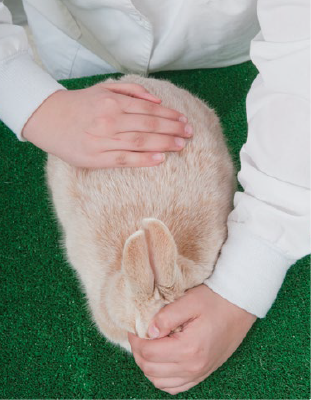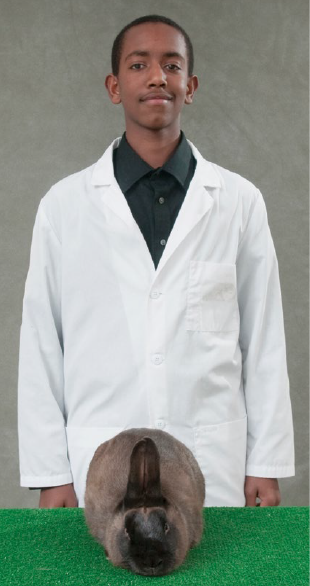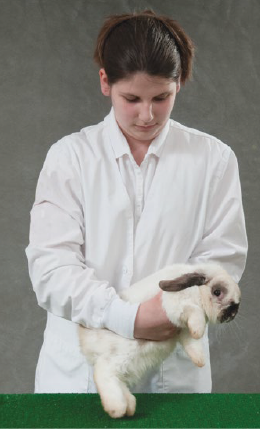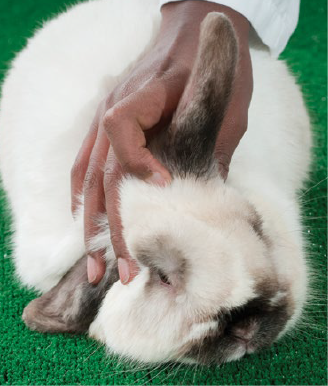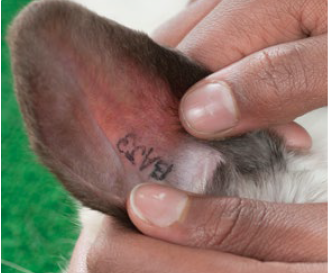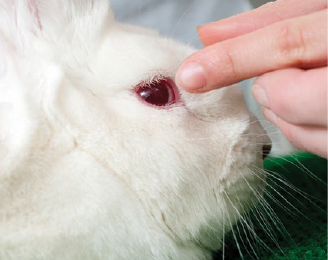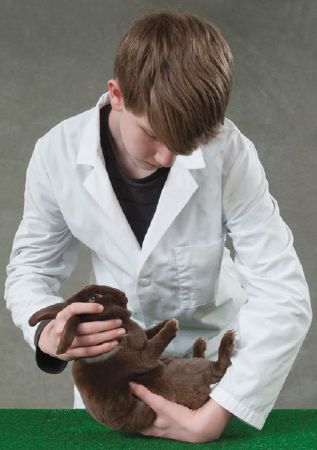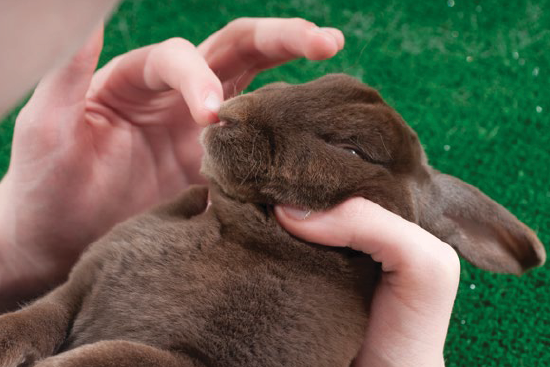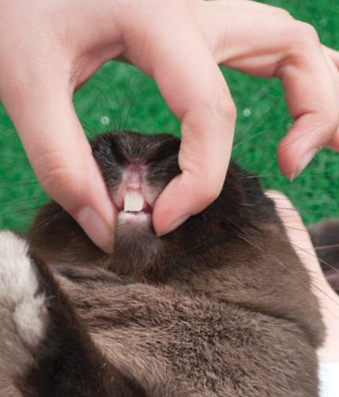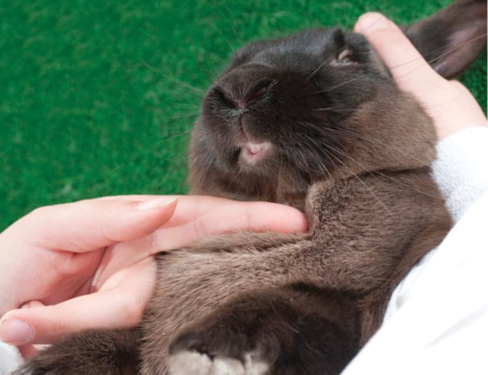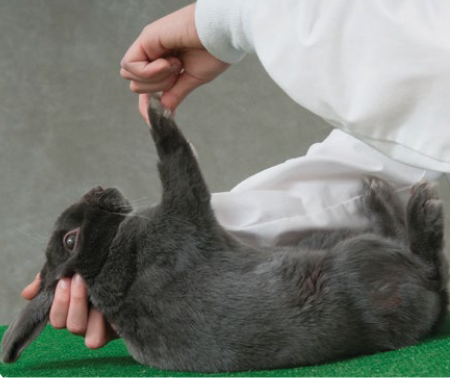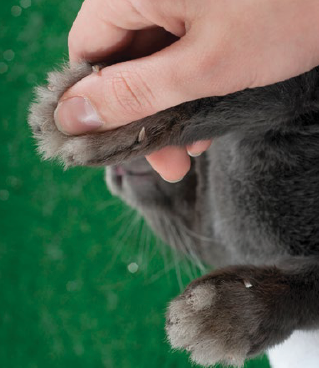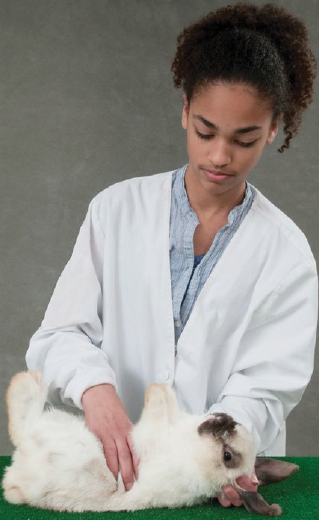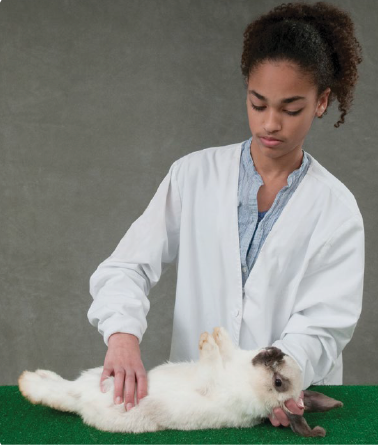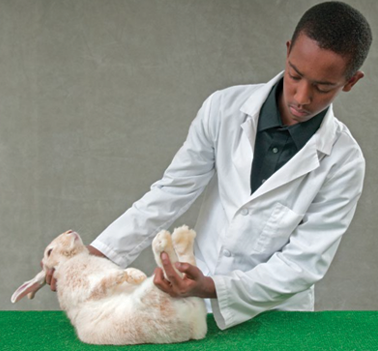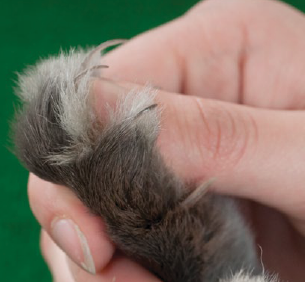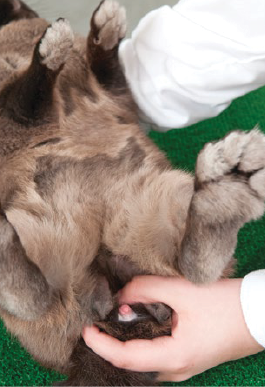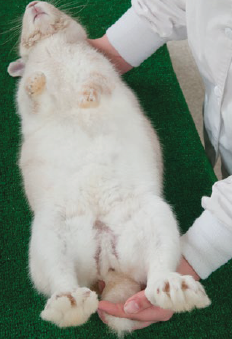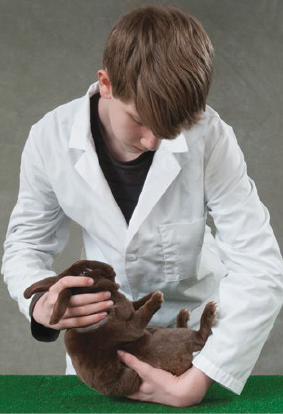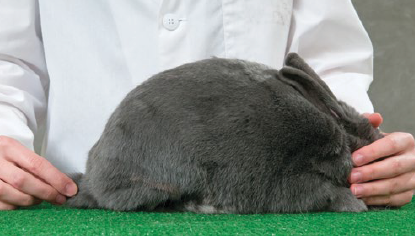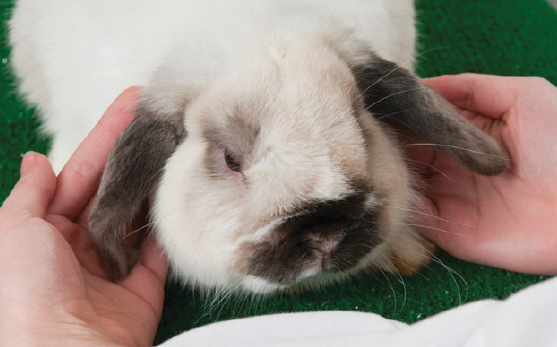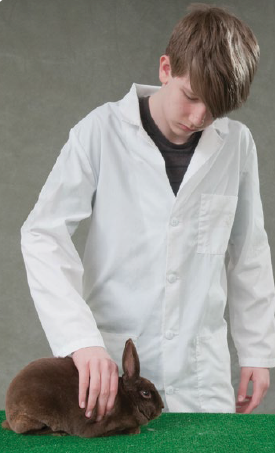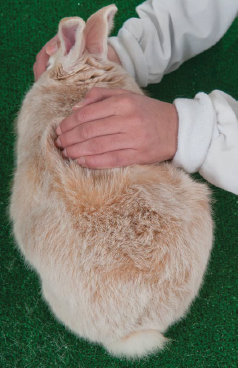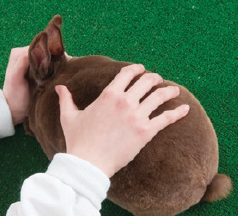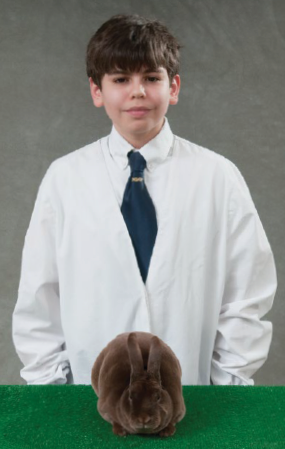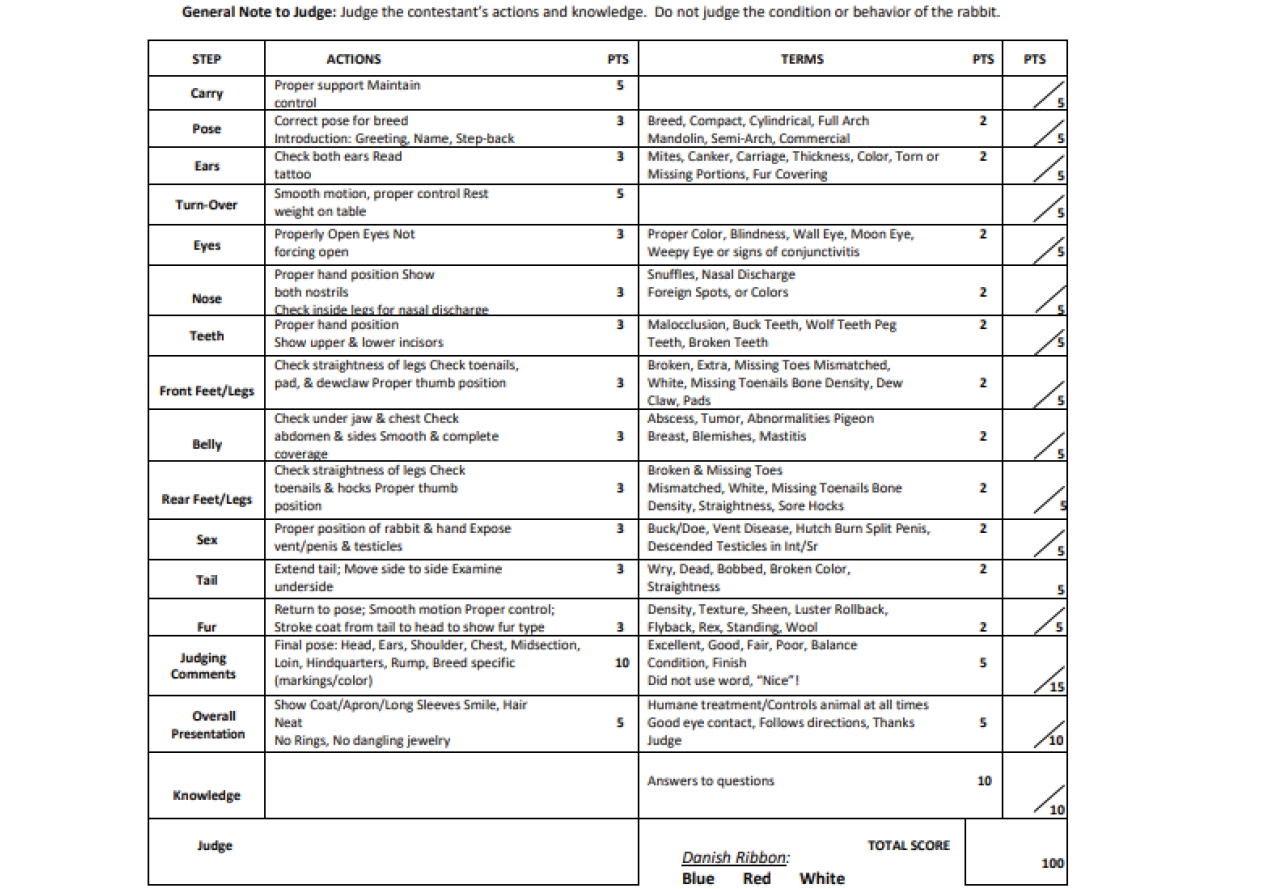In the examination part of the showmanship contest, the judge will attempt to determine each participant’s knowledge of how to check the rabbit for disqualifications and quality. The judge will evaluate you on how smoothly, systematically and confidently you perform each of the examination steps. For each step, begin on the side you are most comfortable with. Be consistent and continue with the same side of the rabbit you chose throughout the exam. Your movements will be smoother and more systematic because you always start on the same side of the rabbit.
The judge will say “examine your rabbit” when it is time to begin. The examination includes the following steps:
Step 1. Lift and turn the rabbit sideways with one hand under its chest and the other hand under its rump for support. Place the rabbit sideways on the table.
Step 1.
Step 2. Starting with the head, gently squeeze the base of each ear one at a time.
Step 2.
Step 3. Open and examine each ear to make sure that the rabbit does not have ear mites. Also, check for any nicks in the ears and note tattoo number if present.
Step 3.
Step 4. Check your rabbit’s eyes by pointing your finger at each eye. Do not touch the eye. Do this to ensure the animal is not blind. Show the judge that your animal does not have weepy or cloudy eyes. Identify and state the correct eye color for your specific breed to the judge.
Step 4.
Step 5. Turn your rabbit smoothly onto its back. Place the palm of one hand directly in front of the rabbit’s face. Cup the palm of your other hand around the shoulders of the rabbit, directly behind the base of the ears. Never lift by the ears. Appropriate finger placement will depend on which finger placement option you choose. Support the animal by gently holding its shoulders with your cupped hand. Try not to grasp the skin and fur. While holding the shoulders and ears, use your opposite hand to support the rabbit’s hindquarters. Lift the front end and roll the hindquarters under. Do not let go of the shoulders. Release your hand from the rump to proceed with the exam. Make sure you provide adequate support for the rabbit when you turn it over. Do not allow the animal to struggle or kick.
Step 5.
Note: Turning the rabbit on its back is a very important step because the judge will observe whether the rabbit is under your control while you perform the examination. Slow and smooth movements help maintain control.
The rabbit now should be positioned with its head either to your right or to your left, depending on whether you are right- or left-handed.
Step 6. Point your index finger to the rabbit’s nose area and gently touch it to look for any discharge.
Step 6.
Step 7. Approaching the rabbit from above, pull back its lips with your thumb and index finger to show the judge the condition of its teeth. Talk to the judge about whether you can see any cracked, chipped, broken or buckteeth (malocclusion).
Step 7.
Step 8. Check the throat or dewlap area of your rabbit for abscesses or tumors by stroking under the chin with the flat backside of your finger. Describe to the judge what you are doing and what you have found.
Step 8.
Step 9. Gently pull each front leg up separately to see if the legs are straight, crooked or bowed.
Step 9.
Step 10. With your thumb, gently press the footpad of your rabbit to extend the front toenails to check the color of the nails and to look for missing or broken nails. Check each toe and do not forget the dewclaw. With some breeds, you may need to pull the fur back to expose the nails.
Step 10.
Step 11. Cup and slide your hand over the chest and abdominal areas of your rabbit. Check for abscesses, tumors or other abnormalities. Describe what you find to the judge.
Step 11.
Step 12. When your cupped and sliding hand reaches the thigh area of the rabbit, gently squeeze the hind legs together to determine their straightness and note if the back legs are parallel.
Step 12.
Step 13. Support the hind legs of your rabbit with your hand and use your thumb to examine each hock area for signs of sore hocks. You also may grab each foot individually, as long as you use your thumb to examine it.
Step 13.
Step 14. With your thumb, gently push on the rear footpads to extend the toenails out so you can check the color and look for missing or broken toenails. With some breeds, you may need to pull back the fur to expose the nails.
Step 14.
Step 15. Check the animal’s sex by holding its tail between your pointer and middle fingers and pressing down lightly in front of the sex organ with your thumb. Examine the area for any signs of disease.
Step 15.
Step 16. While still holding the tail between your two fingers, slide your fingers from the base to the end of the tail to determine whether the tail has been broken.
Step 16.
Step 17. Place your free hand under the rabbit’s rump and gently roll it back onto its feet so the rabbit is facing sideways. Cover the rabbit’s eyes to control it and keep it calm.
Step 17.
Step 18. With your free hand, gently pull the tail out and release it to examine the tail for abnormalities. Check for proper tail carriage and to be sure the rabbit does not have a wry or screw tail.
Step 18.
Step 19. Place the rabbit’s ears according to its breed standard, checking for proper ear carriage (pictures to the right).
Step 19.
Step 20. Check the quality of the animal’s body type and flesh condition by cupping your hand over the rabbit’s shoulders and slowly sliding your hand down to the base of the hindquarters.
Step 20.
Step 21. Examine the fur quality, texture and density of your rabbit by running your hand from the tail to the head and back to the tail.
Wood breed rabbit.
Rex-furred rabbit
If you have a wool breed rabbit, do not run your hand on the animal. Instead, gently fluff the wool from back to front to check the length and condition. Then gently grasp the wool on the sides of the rabbit to check the density.
If you have a rex-furred rabbit as pictured with the dark brown fur, gently press into the fur to check for resistance and then release your hand.
Step 22. Pose the rabbit facing forward and stand with your hands at your sides. This completes the examination.
Step 22.




